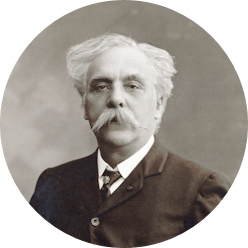
Gabriel Fauré
May 12, 1845 - Pamiers (France) — November 4, 1924 - Paris (France)
© Pierre Petit (1905)
About
A composer at the turning point between two centuries, Fauré was both immersed in the heritage or Romanticism while being acquainted with modern music like Schoenberg’s Pierrot Lunaire. A pupil of Saint-Saëns at the Niedermeyer School, he received a solid education, became an accomplished pianist and organist, studied the classics and, like all his generation, was passionate about Wagner. Respected by Franck, D’Indy, Duparc, Lalo and Debussy, Fauré seemed to be the last Romantic of his generation.
An organist at Rennes then in Paris, Fauré spent his youth travelling. In 1877, he followed Saint-Saëns to Weimer to attend the first performance of Samson and Dalila, which was produced through Liszt’s incentive. In 1896, he was appointed organist at the Madeleine and professor of composition at the Paris Conservatoire. Every young composer sought this master’s tuition with his great experience and knowledge of the past’s treasures. In 1905, he became director of the Conservatoire and in 1909, a member of the Institute.
Fauré, far from grandiloquence, remained a discreet man and composer of a subtle and sensitive art. His inventive qualities disconcerted many. Within the gentleness of his chamber music, the transparency of his religious music and the complexity of certain piano pieces, Fauré left behind numerous captivating scores. Sometimes put aside or ignored, nowadays numerous young composers claim inspiration from this master’s art: an art of light versus dark, half tones and secrecy.

